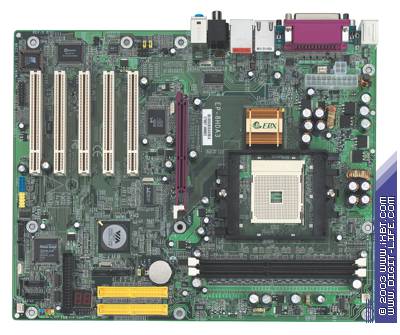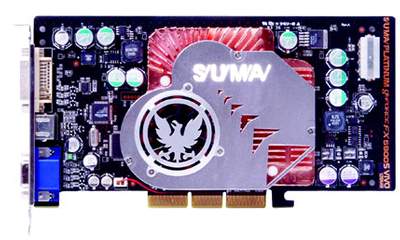 |
||
|
||
| ||
Intel stops production of 1.40GHz Pentium III and some more New exhibits for our Hardware Museum: #9 Revolution IV graphics card with 16MB SDRAM EPoX introduces EP-8HDA3+ motherboard on VIA K8T800 ALi/ULi chipset roadmap. Prototypes on M1683 and M1689 PLATINUM GeForce FX 5900S VIVO from S/U/M/A/ — a new GeForce FX 5900 card Samsung: 4 Gb NAND, Fusion Memory and new technologies Intel stops production of 1.40GHz Pentium III and some more Intel officially announced plans to stop the production of:
The programme was launched on September 16, 2003, with orders to be accepted until November 7. Reasons are standard: demand reduction and the focus on newer processors.
New exhibits for our Hardware Museum: #9 Revolution IV graphics card with 16MB SDRAM Our exposition was extended with an interesting graphics card from already non-existent NumberNine or just #9. In its time the company wasn´t a total leader, but rather a respected vendor especially in the segment of professional page making on Apple systems. The #9 Revolution IV 16MB SDRAM is interesting not only as a product, but also as a memorial to #9 staff. If you look at the PCB against a light source, you´d see lyrics of The Beatles which NumberNine guys were fans of.
    EPoX introduces EP-8HDA3+ motherboard on VIA K8T800 Having become one of the manufacturers who supported the new AMD Athlon 64 family, EPoX introduced a new EP-8HDA3+ motherboard on VIA K8T800 chipset. EP-8HDA3+ is designed for 754-pin Athlon 64 processors, with key specs being the following:
ALi/ULi chipset roadmap. Prototypes on M1683 and M1689 Computex 2003 that took place last week indicated high interest to products of ULi Electronics, ALi´s daughter company. It seems after some time in shadows a new expansion is planned, now under the ULi brand. After parting from Ali in July 2003, ULi Electronics already earned NT$600 million for July and August. Taiwanese The Digitimes referring to Uli reported that the company plans to focus on systems-on-chip (SoC) as well as K8 products. As for the single-channel P4, ULi believes the competition to be too strong and revenues too low to be seriously interested in this market. So the company will continue shipping its P4 chipsets only to selected customers. The same for dual-channel P4 solutions: Intel is too strong in this segment, so ULi doesn´t see any sense in such competition. As for mobile chipsets, ULi will continue its partnership with Trident Microsystems. However, ULi doesn´t deny its presence on the P4 market at all. According to provisional information, in Q1 next year the company is to announce the M1683 chipset supporting Pentium 4 with up to 1GHz FSB, DDR500 memory, etc. As for the Athlon 64 chipsets, already in December 2003 a new single-chip M1689 is to replace the M1687 Northbridge. According to ULi, coupled with popular M1563 Southbridge, M1689 would cost 30% less than competing products. To illustrate the news below are some photos made by our Alexander Vorobyev at Computex 2003. This is an M1689 chipset flowchart:
 And this is a prototype on the aforementioned chipset:
 M1683-based P4 prototype:
 PLATINUM GeForce FX 5900S VIVO from S/U/M/A/ — a new GeForce FX 5900 card Korean S/U/M/A announced a version of its NV35-based videocard, PLATINUM GeForce FX 5900S VIVO. 
As they say at BrainBox, the card is a cheaper alternative to GeForce FX 5900 Ultra cards, that has the same functionality. Samsung: 4 Gb NAND, Fusion Memory and new technologies Samsung Electronics Co., Ltd. announced 70 nanometer 4GbNAND Flash memory and an 80nm DRAM chip. In addition, the company announced a single chip memory solution, called fusion memory, which takes the multi-chip package and system-in-package concepts one step further to deliver a single design combining memory and logic. Samsung´s 4Gb NAND flash memory incorporates a 70nm node design that allows to achieve memory cell´s size of 0.025µm?. The 4Gb NAND flash is the industry´s first to feature a 300-angstrom tungsten gate, which reduces inter-cell resistance and noise level to ensure higher performance in multi-gigabit memory designs. Samsung expects the new tungsten gate to be adaptable in up to 50nm designs. In DRAM sector, Samsung announced an 80nm 512Mb monolithic device, that has adopted Recess Channel Array Transistor (RCAT) technology to enhance data refresh features. The RCAT technology minimizes cell size by building a three-dimensional transistor to pair each capacitor in the DRAM circuitry, significantly enhancing density. The new DRAM utilizes low resistance tungsten gates for higher performance and low temperature, and a high-k oxide process for low voltage requirements that go beyond 1.5V, a standard feature of DDR3 DRAM. Mass production of the cutting edge technology will begin with 1Gb to 512Mb densities at 3Gigabit per second and faster speeds. Well, as for the fusion memory, it is an integrated, single-chip that combines high density memory and logic, together with software availability. The first Fusion memory device is a 512Mb NAND flash memory with logic interface built on a single piece of silicon, called OneNAND. Specialists from Samsung expect that the new Fusion technology will allow to refuse from NOR Flash+Memory combinations in applications with high data processing throughput requirements.
Write a comment below. No registration needed!
|
Platform · Video · Multimedia · Mobile · Other || About us & Privacy policy · Twitter · Facebook Copyright © Byrds Research & Publishing, Ltd., 1997–2011. All rights reserved. |